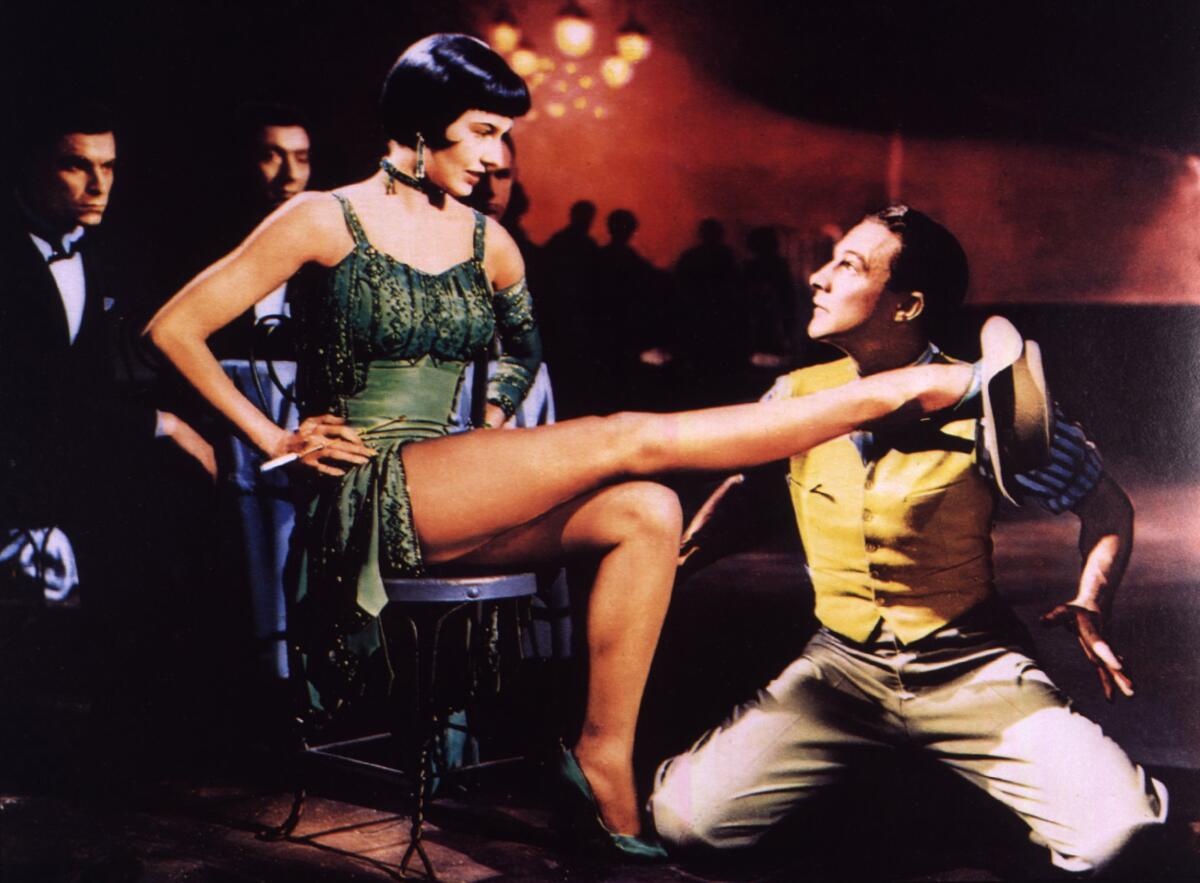From the Archives: ‘American in Paris’ hits glamor peak

Parisian glamour, albeit this may be studio synthetic, glows resplendently from the screen in “An American in Paris,” a top venture in song and dance, which had a dazzling premiere last night at the Egyptian Theater.
In presenting this picture themed by the music of George Gershwin, Metro-Goldwyn-Mayer has succeeded in creating festivities that ideally suggest the mood of oncoming holidays, and that won the acclaim of a star-bedecked first audience.
“An American in Paris” assures enjoyment for the public as few pictures have done thus far this season. It is original, gay and different; it has plenty of entertainment.
It climaxes in a radiant artistic carnival that is indeed unique. It is, in a word, an accomplishment to satisfy practically all beholders, and especially those who consider a splendiferous film musical one of the best reasons for attending a theater.
Kelly dominates
Gene Kelly stars in this picture — in fact, dominates it. Simultaneously the production introduces Leslie Caron as a singularly talented ballerina, and presents Oscar Levant and Georges Guetary in outstanding musical roles.
Nina Foch, who is veritably a new and fascinating personality, is also highly important in its plot.
Alan Jay Lerner, of “Brigadoon” fame, wrote the story and screen play, Ira Gershwin the lyrics, while Vincente Minnelli directed for producer Arthur Freed.
This combination may truly be rated a successful one, and Kelly may take a special bow for his choreography, particularly for the remarkable elaborate ballet inspired by the paintings of French artists. This is in the fantasy realm in which the star excels.
Naturally this art climax is “An American in Paris” as composed by Gershwin, and runs some 17 minutes as an ever-changing kaleidoscope of Technicolored beauty.
“Concerto in F” is notably proffered by O. Levant. “Embraceable You” is danced by Miss Caron.
“By Strauss” early captivates the audience as executed by Kelly, the fine-volced Guetary, and Levant, with many mirthful interludes.
‘I’ve Got Rhythm’
Kelly has a splendid time with “I’ve Got Rhythm,” performed with an aggregation of French children. “Tra-la-la,” “Love is Here to Stay” and “S’ Wonderful” are effectively incorporated, in addition to the very flashy “I’ll Build a Stairway to Paradise” offered by Guetary and the chorus.
This is veritably a Gershwin revel for those who are fond of his music, admirably enhanced with eye appeal, which makes even all too familiar numbers take on new life.
Miss Foch appears as a would-be wealthy patron of Kelly, who is a young American attempting to paint in Paris. However, a little perfume saleslady (Miss Caron) captures his fancy.
He doesn’t know that she is affianced to Guetary, who is fostering her dancing career. Levant is aware of this situation. He has a terrific comedy scene, excellently played, when he views as imminent the danger that Kelly will disclose to Guetary his romantic interest in the girl.
In Levant style
As Jerry Mulligan Kelly has a “show me” attitude and dialogue that might just as readily have been written for Levant as for himself. He plays the part industriously and for good results. His enormous animation is the life of the whole affair, whether you will appraise his as a full-fledged characterization or not. It has many first-rate attributes in that domain.
Miss Caron invests her assignment with the Parisian air, charm and simplicity. It is hard to decide whether she is an ideal screen type, but her dancing is notable.
Miss Foch is definitely competent in her portrayal, while Levant is effectively in style. Guetary has quality. Eugene Borden, Martha Bammatre and Mary Young, who dances with Kelly to score a big hit, are others in the production.
Popular triumph
One may easily conjecture that “An American in Paris” will score as a huge popular triumph.
Among premieres this was a real conquest in proving that under the right circumstances these events may still rival the historic past. The turnout of picture celebrities, the fanfare that went with the first screening, and all else, evidenced that gala days can be effulgently renewed.
More to Read
Only good movies
Get the Indie Focus newsletter, Mark Olsen's weekly guide to the world of cinema.
You may occasionally receive promotional content from the Los Angeles Times.










